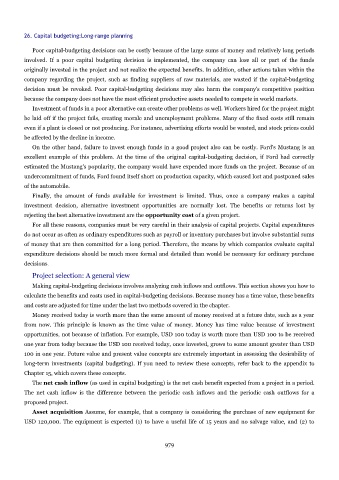Page 978 - Accounting Principles (A Business Perspective)
P. 978
26. Capital budgeting:Long-range planning
Poor capital-budgeting decisions can be costly because of the large sums of money and relatively long periods
involved. If a poor capital budgeting decision is implemented, the company can lose all or part of the funds
originally invested in the project and not realize the expected benefits. In addition, other actions taken within the
company regarding the project, such as finding suppliers of raw materials, are wasted if the capital-budgeting
decision must be revoked. Poor capital-budgeting decisions may also harm the company's competitive position
because the company does not have the most efficient productive assets needed to compete in world markets.
Investment of funds in a poor alternative can create other problems as well. Workers hired for the project might
be laid off if the project fails, creating morale and unemployment problems. Many of the fixed costs still remain
even if a plant is closed or not producing. For instance, advertising efforts would be wasted, and stock prices could
be affected by the decline in income.
On the other hand, failure to invest enough funds in a good project also can be costly. Ford's Mustang is an
excellent example of this problem. At the time of the original capital-budgeting decision, if Ford had correctly
estimated the Mustang's popularity, the company would have expended more funds on the project. Because of an
undercommitment of funds, Ford found itself short on production capacity, which caused lost and postponed sales
of the automobile.
Finally, the amount of funds available for investment is limited. Thus, once a company makes a capital
investment decision, alternative investment opportunities are normally lost. The benefits or returns lost by
rejecting the best alternative investment are the opportunity cost of a given project.
For all these reasons, companies must be very careful in their analysis of capital projects. Capital expenditures
do not occur as often as ordinary expenditures such as payroll or inventory purchases but involve substantial sums
of money that are then committed for a long period. Therefore, the means by which companies evaluate capital
expenditure decisions should be much more formal and detailed than would be necessary for ordinary purchase
decisions.
Project selection: A general view
Making capital-budgeting decisions involves analyzing cash inflows and outflows. This section shows you how to
calculate the benefits and costs used in capital-budgeting decisions. Because money has a time value, these benefits
and costs are adjusted for time under the last two methods covered in the chapter.
Money received today is worth more than the same amount of money received at a future date, such as a year
from now. This principle is known as the time value of money. Money has time value because of investment
opportunities, not because of inflation. For example, USD 100 today is worth more than USD 100 to be received
one year from today because the USD 100 received today, once invested, grows to some amount greater than USD
100 in one year. Future value and present value concepts are extremely important in assessing the desirability of
long-term investments (capital budgeting). If you need to review these concepts, refer back to the appendix to
Chapter 15, which covers these concepts.
The net cash inflow (as used in capital budgeting) is the net cash benefit expected from a project in a period.
The net cash inflow is the difference between the periodic cash inflows and the periodic cash outflows for a
proposed project.
Asset acquisition Assume, for example, that a company is considering the purchase of new equipment for
USD 120,000. The equipment is expected (1) to have a useful life of 15 years and no salvage value, and (2) to
979

